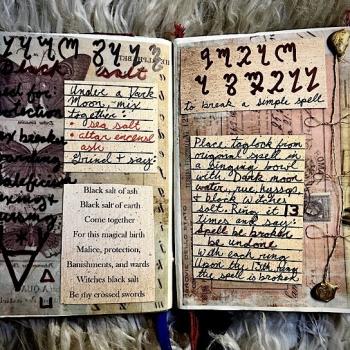Mark was a literary genius. He invented the “gospel” as a new literary genre. That is comparable to Aeschylus’ invention of drama. But, like Wagner, Mark was anti-Semitic. He despised “the Jews.”
Please be aware that I am here boiling down almost 250 years of scholarship focused on the gospels. The history of that scholarship is one of liberals beating the literalists back step by step with a wand of reason, showing that the gospels are works of theology, not history. We know how the gospels were written. Anything written the same way now would be considered fiction. Probably any objection to my argument you can think of was thoroughly discussed and shot down a very long time ago.
Mark’s gospel is often called a “Jewish gospel”—but it is not. Almost every detail about Judaism in it is factually wrong. Mark writes from the viewpoint of an anti-Semitic Gentile living somewhere outside Jewish territory, perhaps in Antioch. Mark lumps the population of Judea together as “the Jews.” That is stereotyping; that is bigotry. Mark knows nothing about the Pharisaic Houses of Hillel and Shammai, about the two kinds of Zadokites, let alone about the Essenes. He says, “the Rabbis and the Pharisees,” thinking they are two separate groups.
The oldest (albeit legendized) information we have about Mark is in Irenaeus, who, ca. 160, says that “Mark was Peter’s secretary and wrote down what Peter preached, but not in the same order.” That is, Mark had a theory on how to organize the stories about what Jesus had said and done; they had floated about as isolated units in the oral tradition, often magnified by the rumor effect. He arranged them into a “life of Jesus” that set forth his own theology, which was “Adoptionist”: he believed that Jesus became the Messiah only when the Holy Spirit entered into him at his baptism and drove him out into the “wilderness” (which Marxsen proved was a theological term, not a geographic location). If that story is historical at all, I think it preserves a memory that Jesus underwent the kind of ecstatic illumination that the Gnostics called an Awakening. That is why he apparently believed himself to be a “Prophet like Moses” with full Rabbinic authority to interpret the Torah. His original followers, who remained observant, continued to call him the True Prophet for centuries (look at the Clementine Homilies). If so, then Jesus was the first Gnostic, and the new information about him in the Gnostic gospels is historically valuable.
Being raised Catholic, I heard only the bits and snippets of the gospels read at Mass; those bits, like the harmonized “lives of Jesus” that I read, obliterated the radical differences between the four gospels. About 1970, I happened upon Hugh Schonfield’s excellent translation titled The Authentic New Testament. He recommended reading Luke’s gospel first, since it summarized most of what was important in the other three, but, since he said that Mark’s was written first, I decided to read it first. I have always been glad that I did.
In Mark, read straight through with fresh eyes for the first time, I found the story of an extraordinary preacher and faith healer who gradually came to believe he was the Messiah. It read like straightforward reporting of historical facts—because that was a major aspect of Mark’s literary genius. It also seemed like familiar turf, similar to the stories I had heard from faith healers at meetings of the Berkeley Psychic Society. But faith healing is an ordinary human talent. Jesus was apparently very good at it—but that has nothing to do with whether he was the Messiah. In Matthew, Mark’s story was turned upside down: Jesus knows all along that he is the Messiah—and does a little faith healing on the side. That reading focused me on the “Synoptic Problem,” which I pursued as part of my doctoral program at the GTU during the late 1970s.
As a member of a Pauline (nonobservant) community, Mark’s agenda was to denigrate Jesus’ original circle of family and students, of whom he thus gives us a very distorted picture. He consistently describes them as being stupid and unbelieving. However, the Gospel of the Nazarenes tells us that Jesus’ entire family was baptized when he was. Jeffrey Buetz points out the names of all four of Jesus’ brothers in the lists of the “Twelve Apostles.” So it makes sense why Jesus’ brothers are among the very first missionaries, i.e., apostles, according to both Paul and Acts.
Some of what Mark says about Jesus is not problematic, but much of it is. For example, consider a (compound) scene where Jesus is criticized by Rabbis from Jerusalem for healing a man in a synagogue on the Sabbath by forgiving his sins. The problems here are:
- According to Robert M. Price, there were neither Rabbis from Jerusalem nor synagogues in Galilee (which “hated the Torah”) in Jesus’ time. (Much of what I’m saying here is informed by Price’s marvelous essay, “Messiah as Mishna,” available online.)
- Healing on a Sabbath was always allowed. Judy Harrow told me Hillel taught that one not only can, but must break any commandment (except for the three against blasphemy, incest, and murder) in order to save a life.
- Healing illnesses by forgiving sins or driving out evil spirits was not unique to Jesus. It was the standard medical model at the time; the Essenes healed illnesses the same way.
Such scenes portray Jesus as being willing to break commandments in order to be compassionate, but the “Rabbis and Pharisees” as being legalistic and callous. This is a distorted picture of the actual historical controversies. According to both Hans Kueng, in To Be a Christian, and Rabbi Harvey Falk, in Jesus the Pharisee, Jesus was a Rabbi of the House of Hillel. The Talmud gives many examples in which its rulings were more compassionate, but those of their theological opponents, the House of Shammai, were legalistic. What we see in the gospels is a Rabbi of Hillel’s party lambasting the opposition for their legalism, lack of compassion, hypocrisy, and so forth. The other Rabbis objected to his claiming individual, not collective, authority to interpret the commandments. There is much more to say about Jesus as a Rabbi—but not here.
Matthew did not think Mark’s gospel was “gospel truth”; he thought it was inadequate, so he rewrote it, but kept Mark’s story line, not knowing any other, and thus kept much of Mark’s anti-Semitism. John also thought Mark inadequate and created a different story from the raw materials; he knew more about Judaism than Mark did, but was even more anti-Semitic. Luke was probably a Gentile bishop in Pauline territory; he was the least anti-Semitic and the most knowledgeable of the four. He rewrote all three of the gospels, but kept Mark’s story line, and added a second volume; Luke/Acts was a best-seller in the second century. But he too was writing propaganda, sucking up to the Romans. His story in Acts about Paul being hired to persecute the Christians in the late 30s is pure fiction. According also to Acts, the Nazarenes were observant and accepted as being fully Jewish; and Paul’s problems began only in the late 50s, when he visited Jerusalem and was accused of teaching Jewish converts that they no longer needed to keep kosher. He was almost lynched, but, as a Roman citizen, appealed to the Emperor; Luke avoids detailing how little good that did for Paul.
History Ends at Gethsemane.
However, the most virulent anti-Semitism in Mark and the other gospels comes after Jesus’ arrest. It is plausible that he celebrated the Seder with his men and women students, then, perhaps after singing the Hallel, went for a walk in the garden, where the Romans and their quislings arrested him. The students fled for their lives; if arrested, they would have been executed also. The Romans and their spies knew perfectly well who and where Jesus was. No one betrayed him. The only Judas among the students was Jesus’ brother, whom he nicknamed “Twin.” The Romans threw Jesus in a cell overnight and took him to Pilate early the next morning. Pilate said, “Crucify him,” and that was that. There were no trials. Michener explains in The Source that normal Roman procedure when they crucified a man was to round up all his family and friends, bring them to the foot of the cross, rape all the women and children, and slit all their throats. There were no witnesses.
Mark’s “Passion” story was propaganda, intended to shift the blame for Jesus’ death from the Romans to the Jewish people. (Mark probably did not invent the story about Judas Iscariot himself, but he used it as part of that propaganda.) He constructed the story by presenting scriptural texts that had been interpreted as Messianic prophecies as if they were accomplished facts. Mark then added the legend of the empty tomb, which was a late development; Paul never alludes to it.
One day in 2007, in my office room in the front of the huge house we were renting on Pine Bluff Avenue in Paris, Texas, I was wondering, “What did happen to his body?” And I realized we know, but do not want to know. The Romans threw the bodies of executed criminals into the gulch behind the temple where the temple of Moloch had once stood; that was Gehenna. I was seized by a vivid visualization and found myself descending mentally and emotionally into the pits at Auschwitz. Surrounded by the rotting, stinking corpses of dead Jews, I looked down at the body of a pious Rabbi murdered by fascist dictators, and I wept. Damn it, I wept. I had not known I would burst into tears. And I asked, “God, will we ever get any better?” At this moment, with a new wave of neo-Nazis rising in Europe, with a psychopathic narcissist running for our Presidency, I have no answer.
My well-educated, liberal Christian friends—Catholics, Mormons, Baptists, Anglicans—are not part of the problem. They tend to know as much about Jesus and the gospels as I do—though they might not agree with everything I’ve said. They neither believe or propagate the anti-Semitism in the gospels. But as long as ignorant pastors teach that every word of the Bible is literally true, the gospels will continue to generate and regenerate hatred of Jews. If the leaders of the various Christian churches were to get together and authorize the writing of a new gospel informed by modern scholarship, one that keeps the salvific myths but eliminates the anti-Semitic propaganda, that would be progress toward mental health. I can hope, though I doubt, they might have such courage. The Jews, the gays, the disenfranchised deserve more than an apology.
Will the powers of organized religion listen to a loose canon like me? Of course not. Nevertheless, I will speak truth to power. Silence is violence. We must say, Never Again. Never Again the Holocaust. Never Again the Burning Times. And then we must not merely say, but do, do whatever we can in the pursuit of sanity. Where there is no humanity, we must strive to be human.















